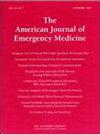即时脑电图快速诊断小儿非惊厥性癫痫持续状态
IF 2.2
3区 医学
Q1 EMERGENCY MEDICINE
引用次数: 0
摘要
背景:非惊厥性癫痫持续状态(NCSE)是儿科急诊科(PEDs)儿童的一个时间关键诊断。诊断延迟是常见的,特别是当孤立的精神状态改变(AMS)是唯一的症状。标准脑电图(EEG)对诊断是必不可少的,但在正常工作时间之外很少使用。即时脑电图(pocEEG)是一种快速的床边替代方法,可以支持在这种情况下早期识别和治疗NCSE。方法本研究描述了在我们的第三PED质量改进项目中使用快速,低成本,双通道pocEEG设备。我们报告了所有病例的描述性数据,并重点关注抽搐发作后的AMS儿童,但没有明显的持续发作活动。结果5例NCSE患儿中,4例经pocEEG诊断为PED。所有患者均在正常工作时间外就诊,院前接受过苯二氮卓类药物治疗,其中4人有潜在的神经系统疾病。在所有病例中,左乙拉西坦是最初的院内静脉治疗;2例需要额外的苯巴比妥。1例发病后23小时标准脑电图显示局灶性癫痫发作;对初始pocEEG的回顾性检查显示发作-间期连续体。结论虽然所有病例均伴有惊厥发作,但脑电图也可帮助诊断无癫痫发作史且原因不明的AMS患儿的NCSE。在我们的PED中,pocEEG提供了一个实用的替代方案,可以在标准脑电图不可用的情况下早期诊断和治疗NCSE。PocEEG可能是一个有价值的工具,及时发现癫痫发作和临床决策的儿科急诊护理。本文章由计算机程序翻译,如有差异,请以英文原文为准。
Rapid diagnosis of pediatric nonconvulsive status epilepticus using point-of-care EEG
Background
Nonconvulsive status epilepticus (NCSE) is a time-critical diagnosis in children presenting to pediatric emergency departments (PEDs). Diagnostic delays are common, particularly when isolated altered mental status (AMS) is the only symptom. A standard electroencephalogram (EEG) is essential for diagnosis but rarely available outside regular working hours. Point-of-care EEG (pocEEG) is a rapid, bedside alternative that may support earlier recognition and treatment of NCSE in such situations.
Methods
This study describes the use of a rapid, low-cost, two-channel pocEEG device during a quality improvement project at our tertiary PED. We report descriptive data of all cases, and focused on children with AMS following convulsive seizures but without apparent ongoing seizure activity.
Results
Of 5 children diagnosed with NCSE, 4 were identified in the PED by using pocEEG. All presented outside regular working hours and had received prehospital benzodiazepines, and 4 had underlying neurological conditions. Levetiracetam was the initial intravenous in-hospital treatment in all cases; 2 required additional phenobarbital. In one case, standard EEG 23 h after presentation revealed focal seizures; retrospective review of the initial pocEEG showed an ictal-interictal continuum.
Conclusions
Although all cases followed convulsive seizures, pocEEG may also assist in detecting NCSE in children with unexplained AMS and no seizure history. In our PED, pocEEG provided a pragmatic alternative that enabled early diagnosis and treatment of NCSE when standard EEG was unavailable. PocEEG may be a valuable tool for timely seizure detection and clinical decision-making in pediatric emergency care.
求助全文
通过发布文献求助,成功后即可免费获取论文全文。
去求助
来源期刊
CiteScore
6.00
自引率
5.60%
发文量
730
审稿时长
42 days
期刊介绍:
A distinctive blend of practicality and scholarliness makes the American Journal of Emergency Medicine a key source for information on emergency medical care. Covering all activities concerned with emergency medicine, it is the journal to turn to for information to help increase the ability to understand, recognize and treat emergency conditions. Issues contain clinical articles, case reports, review articles, editorials, international notes, book reviews and more.

 求助内容:
求助内容: 应助结果提醒方式:
应助结果提醒方式:


